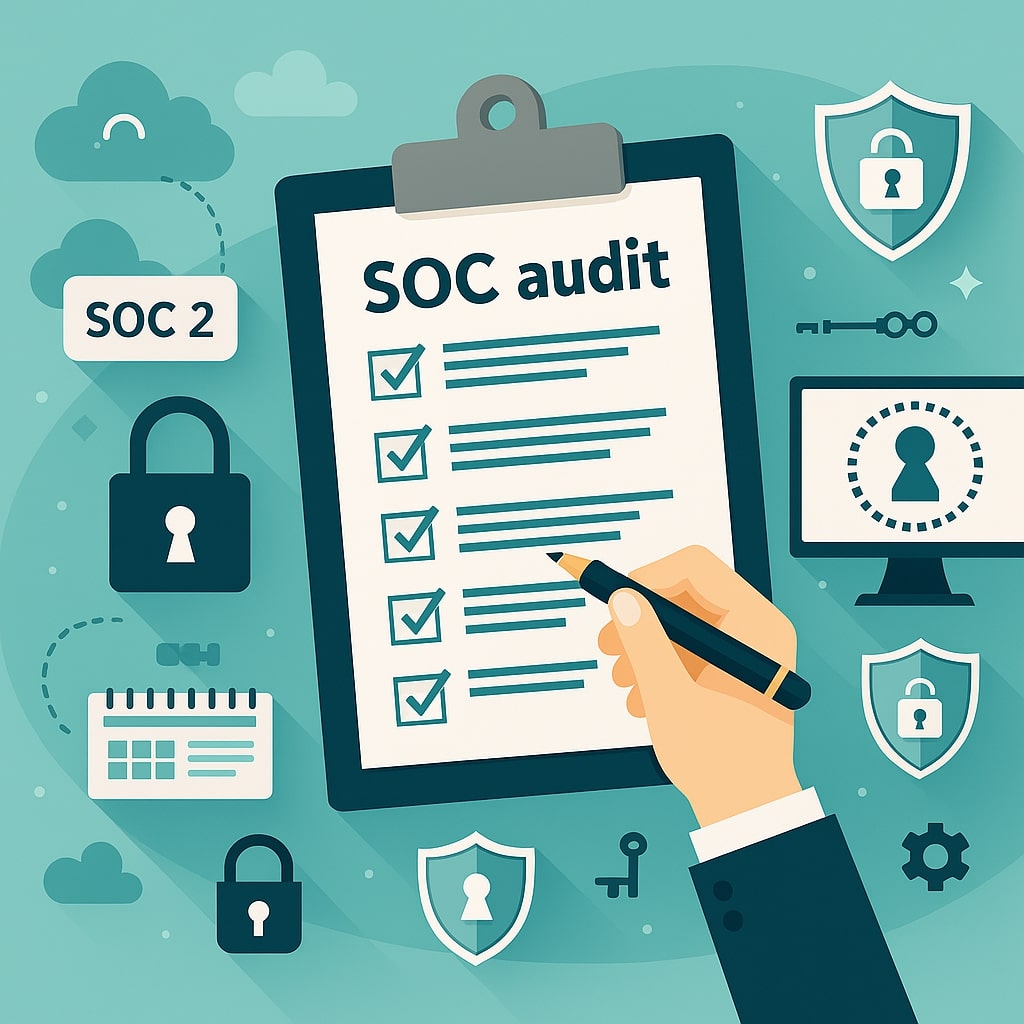If you’re a growing startup or small business aiming to land enterprise clients, SOC 2 compliance isn’t just a checkbox, it’s your way to gain your clients’ trust. This guide walks you through exactly how to prepare for your SOC 2 audit, from risk assessment to documentation and everything in between.
What Is SOC 2 Compliance?
SOC 2 is a cybersecurity and trustworthiness framework designed by the American Institute of CPAs (AICPA). It evaluates how well your company protects customer data through security controls and internal processes.
There are two types of SOC 2 reports:
Type I evaluates whether the right controls are in place at a single point in time
Type II assesses whether those controls are also operating effectively over a longer period (typically 3 to 12 months)
Achieving SOC 2 compliance is a major milestone for a business, not only for closing deals, but also for building a culture of accountability.
Trust Services Criteria (TSC)
SOC 2 audits are based on five Trust Services Criteria:
| Criterion | Focus Area |
|---|---|
| Security | Protection of data and systems from unauthorized access (required) |
| Availability | System uptime and service reliability |
| Processing Integrity | Data is processed accurately and without tampering |
| Confidentiality | Proper handling of sensitive information |
| Privacy | Adherence to privacy policies and user consent |
Every company must cover Security, but depending on your services, you may choose to include more. Understanding these standards helps you know what auditors will expect and how you’ll need to prove compliance.
Step 1: Conduct a Risk Assessment
Before you document anything, closely examine where your organization is most vulnerable. This means identifying where data might be exposed, who has access to sensitive systems, and which practices could open the door to failure. A basic risk assessment will help you prioritize what to fix first, and it’s one of the most valuable steps in your preparation.
Rank each risk by likelihood and impact. This isn’t just for compliance, it’s how you protect your business.
You can perform such internal audits using Humadroid’s Compliance Module.
We recommend maintaining a Risk Register to document and update these risks as your systems evolve.
Step 2: Perform a Readiness Assessment
A readiness assessment helps you map where you stand today versus where you need to be.
Review:
Access control (who has access to what)
Data encryption policies
Logging and monitoring
Incident response plans
Many companies start by comparing current policies against the SOC 2 compliance framework using internal audits or third-party tools.
Step 3: Prepare Your Documentation
SOC 2 isn’t just about having controls, it’s about proving they exist and work.
Start organizing everything from access control policies and incident response procedures to employee training records and change logs. Auditors don’t just want to hear what you do, they want to see evidence that you’ve done it and that it’s been done consistently.
Your documentation should include:
Security Policies
Your formal stance on protecting systems and dataIncident Response Plan
Who does what when things go wrongAccess Logs & Change Management
Records of who accessed what, and whenEmployee Training Records
Evidence that staff have been trained on your practicesRisk Assessment Reports
Including identified risks and assigned owners
Use version control and time stamps to show continuous updates.
Step 4: Undergo the Audit
Once you’re confident in your controls and documentation, it’s time to engage a qualified auditor.
During the audit:
You’ll provide evidence for each TSC you claim
Auditors may conduct interviews or request walkthroughs
You’ll receive a final report detailing findings, strengths, and any gaps
Start with a Type I audit to demonstrate you’ve implemented proper controls. If you’re ready to show long-term consistency, go for Type II.
Step 5: Maintain Compliance Post-Audit
SOC 2 is not a one-time win, it’s an ongoing discipline.
To stay compliant:
Monitor logs and systems continuously
Update policies as your services change
Re-train staff annually
Schedule follow-up internal reviews
Many companies assign this responsibility to a compliance officer who tracks ownership and accountability.
SOC 2 Type I vs. Type II
| Report Type | Scope | Time Frame | Use Case |
|---|---|---|---|
| Type I | Design of controls | At a point in time | Early-stage proof of intent |
| Type II | Design + effectiveness | Over 3–12 months | Mature systems, stronger credibility |
If you’re just starting, Type I is a great first milestone, but Type II earns deeper trust with enterprise buyers.
SOC 2 Audit Cost Considerations
SOC 2 audit costs can vary from $15,000 to $60,000+, depending on:
Number of TSCs included
Scope of systems and processes
Internal readiness (less prep = higher cost)
Auditor reputation and depth
Using SOC 2 compliance software (like Humadroid, Vanta, or Drata) can help reduce preparation time and human error, but it comes with its own subscription cost.
Preparing for a SOC 2 audit can feel overwhelming at first, especially if you have never heard of it before. Once you understand the structure, it becomes a manageable and even strategic process. By identifying your risks, organizing your documentation, and aligning your team, you’re building a clear and understandable business for you to manage easily, and in the process, your business becomes more trustworthy.
With the right preparation, the audit becomes less about paperwork and more about showing that your company is ready to grow responsibly.
If you haven’t yet, take a look at our guide to policy management, it’s a critical part of audit readiness that often makes the difference between a smooth review and a stressful one.

